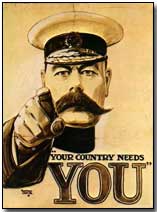Encyclopedia - Derby Scheme
 With popular and mainstream
political opposition to mandatory military service, Britain was the sole
major European power not to have in place a policy of conscription when war
began in August 1914.
With popular and mainstream
political opposition to mandatory military service, Britain was the sole
major European power not to have in place a policy of conscription when war
began in August 1914.
Individual politicians - of whom Winston Churchill was notable - advocated a form of conscription in 1914; such voices were not influential however, and there was broad agreement with Foreign Secretary Sir Edward Grey's assessment that Britain could maintain its European policy with a volunteer army.
Growing battlefront demand however soon outstripped volunteer numbers and in May 1915 Prime Minister Herbert Asquith appointed Lord Edward Derby - himself an opponent of conscription - as Director-General of Recruitment, tasked with rapidly boosting Britain's volunteer army.
Derby's solution was the so-called 'Derby Scheme'. This encouraged men to voluntarily register their name on the principle that once registered they would be called up for service only when necessary. As an added incentive married men were advised that they would only be called up once the supply of single men was exhausted.
Announced in a fanfare of publicity the scheme proved unsuccessful however, and was abandoned in December the same year. Excluding men exempted from military service on account of their occupation (e.g. munitions workers) just 350,000 men had volunteered under the Derby Scheme.
In its stead the government - now led by David Lloyd George - introduced the Military Service Act of January 1916, which set down terms for mandatory military service - that is, conscription. Click here to read details of the act; click here to read of the reaction of conscientious objectors.
A 'Woolly Bear' comprised a German shrapnel shell, which burst with a cloud-like explosion.
- Did you know?
